
|
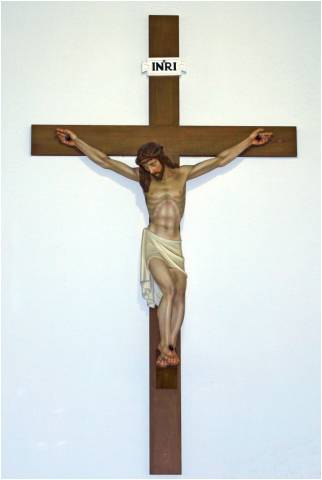
| Crucifix
A crucifix is an image of Jesus on the cross, as distinct from a bare cross. It is a symbol of the crucifixion and Christ's sacrifice. According to St. Paul, “... we proclaim Christ crucified, a stumbling block to Jews and foolishness to Gentiles, but to those who are called, Jews and Greeks alike, Christ the power of God and the wisdom of God." 1Cor 1:23-24
| 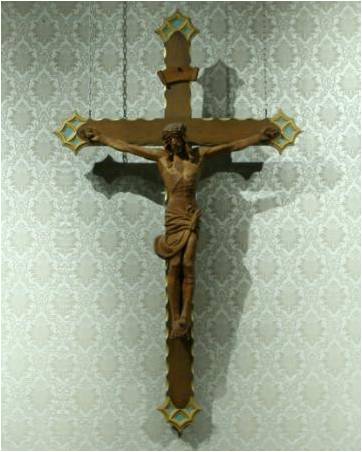
|
|
|
Tabernacle
The word tabernacle means "dwelling place." It is used to house the Eucharist outside of Mass. This provides a location where the Eucharist can be kept for the adoration of the faithful and for later use (e.g., distribution to the sick). At the center of both tabernacles are the letters IHS which is a symbol of Jesus.
|
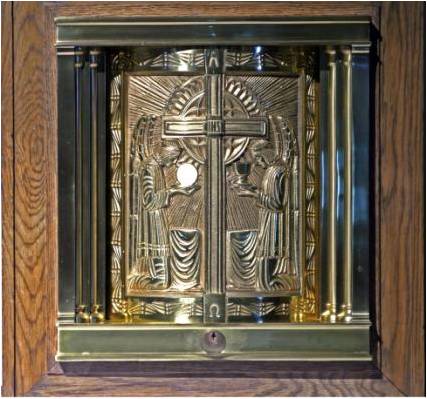
| The tabernacle at St. Patrick's (left) combines the symbol of Christ in the letters HIS, the cross and the alpha and omega letters that represent the eternal nature of Jesus Christ. On either side of the cross are two angels adoring the host and the chalice. At St. Mary's (right) the IHS symbol is combined with the host and a chalice as a symbol of Christ in the Eucharist.
| 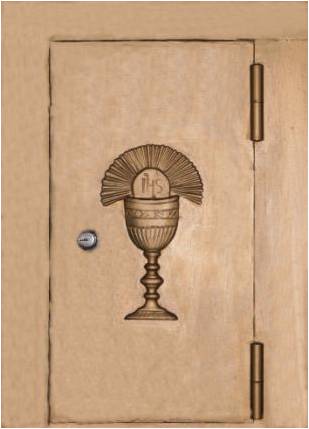
|
|
|
|
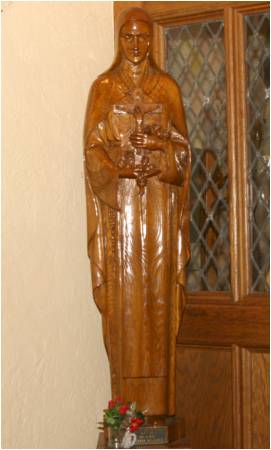
| St. Therese
Born Marie Theresa Martin in 1873, she was granted special permission to enter the cloistered order of Carmelites of Liseux France at the age of 15. She died at the age of 24 after suffering from tuberculosis. Throughout her struggle with her illness she developed a spiritual approached of striving for perfection by being a child of God. Her life of simplicity and humility is a model for us all. She advocated the "little way", the way of simple devotion to God in the routine and ordinary things we do in life.
| 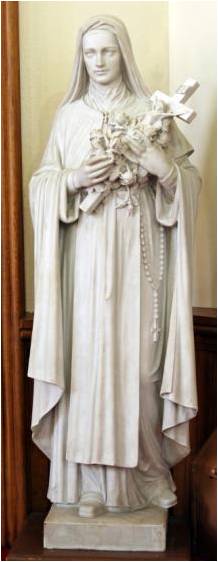
|
|

| Sacred Heart
The devotion to the Most Sacred Heart of Jesus is one of the most widely practiced and well-known Roman Catholic devotions taking Jesus Christ's physical heart as the representation of his divine love for humanity.
| 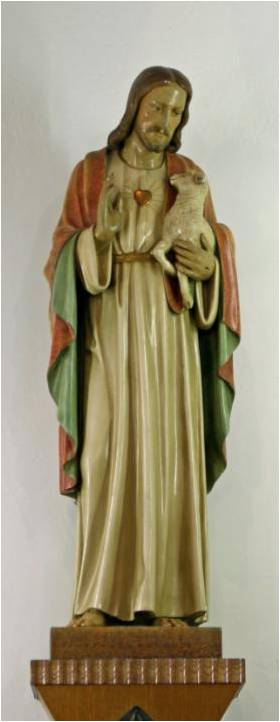
|
|
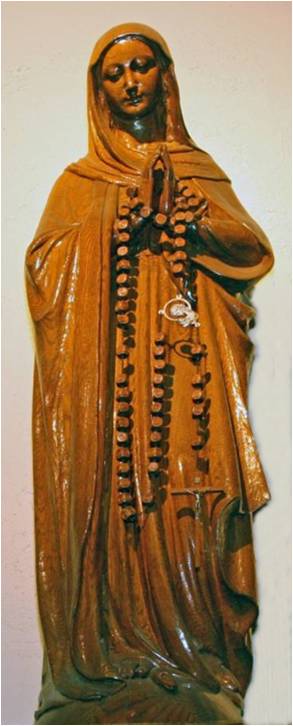
| Blessed Mother
It was through Mary's 'fiat' that God became incarnate and dwelt among us in order to bring Salvation to the human race. Mary was the first teacher of Her Son. She was His first and most faithful disciple. Mary is the Mother of the Church. With Jesus' words from the cross, "woman behold your Son ... behold your mother", She became the Mother of all the faithful. She is the greatest model of obedience and true discipleship for the followers of Jesus Christ.
| 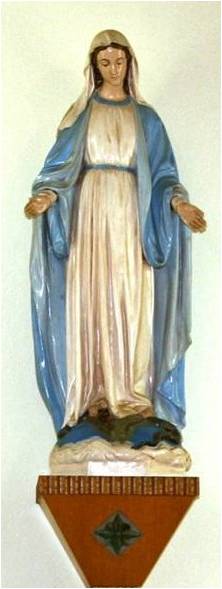
|
|
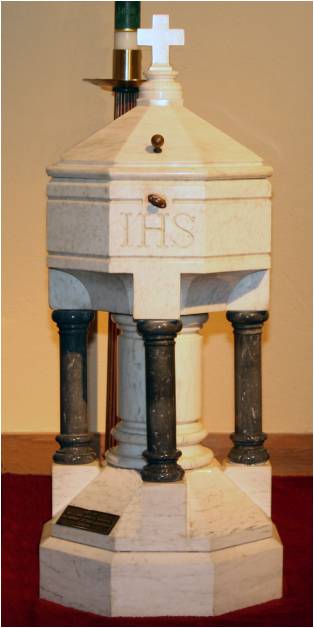
| Baptismal Font - St. Patrick's
The story of baptism can be seen in the symbolism of the font. The font is eight sided and represents the eighth day of creation, eternal life. The story of creation says the world was created in seven days, however, that is not the end of salvation history, not until the last day. We are baptized into the eighth day, eternal life with the risen Christ. The four pillars holding up the font represent the four gospel writers who tell of salvation through Christ. The letters IHS is a symbol for Christ.
|
|
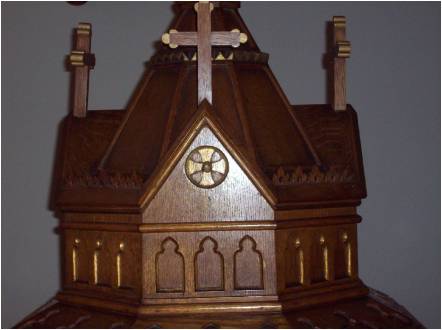
There are four crosses on the font. Salvation comes from Jesus who died on the cross. The story of the cross is told by the four gospel writers. On all eight sides there a series of three decorative arches. Those who come to the font are baptized in the name of the Father, Son, and Holy Spirit."
|
Baptismal Font - St. Mary's
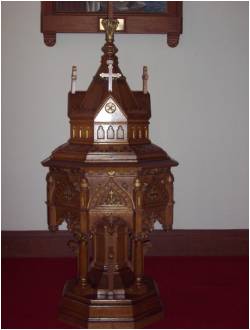
The story of baptism can be seen in the symbolism of the font. The font is eight sided and represents the eighth day of creation, eternal life. The story of creation says the world was created in seven days, however that is not the end of salvation history, not until the last day. We are baptized into the eighth day, eternal life with the risen Christ
|
|
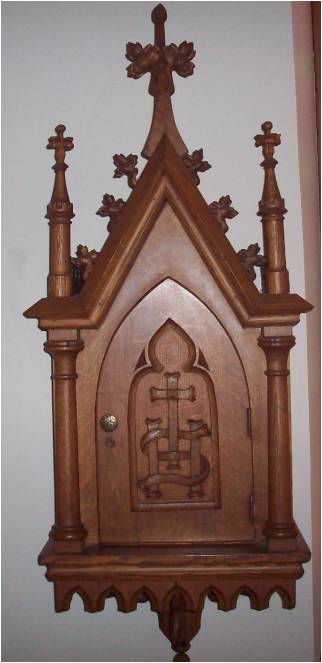
| Ambry - St. Mary's
The ambry is where the holy oils are stored; Oil of the Sick, used in the sacrament of Anointing of the Sick, Chrism Oil, used in Baptism, Confirmation, and Holy Orders, and Oil of Catechumens used in Initiation Rites. The door of the Ambry has the letters, IHS superimposed upon each other. These are the first three letters of the word "Jesus". In each sacrament we experience Christ. We can see this through the symbolism of the Ambry, including the crosses on top. To enter into the Ambry is to enter into an experience of the Divine through the sacraments.
|
|
|
Ambry - St. Patrick's
The ambry is the cabinet where holy oils are stored. We keep three oils there; the oil for anointing the sick(OI), the oil for anointing catechumens(OC) and chrism for baptism, confirmation, priesthood and the consecration of altars(SC). The Holy Oils are visible to the assembly not merely as a display, but to remind the community that God chooses to use the things of this earth to impart God's grace.
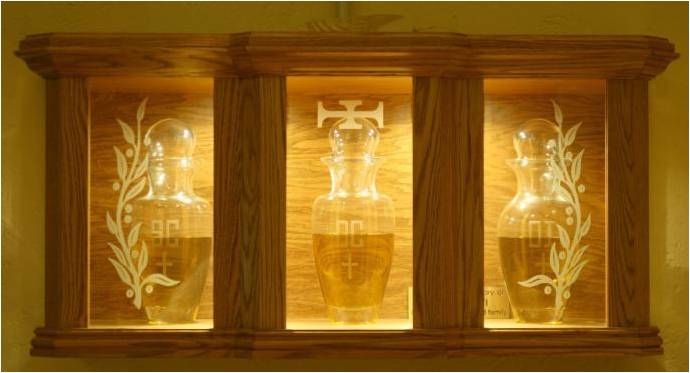
|
The previous ambry was stored in a niche in the wall of the sanctuary of St. Patrick's. The words Olea Sancta means Holy Oil.
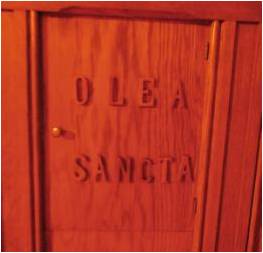
|
|
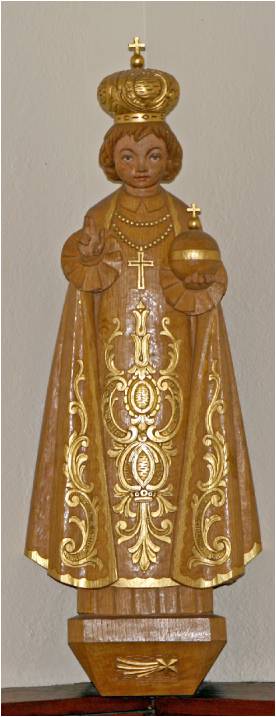
| Infant of Prague
The infant Jesus has held a special place of devotion for Eastern Europe Catholics for nearly 300 years. The original wood and wax statue was brought to Czechoslovakia from Spain in the 1500's. It depicts the infant Jesus clothed in royal clothes. In one hand the world and with the other giving a blessing to the world.
|
|
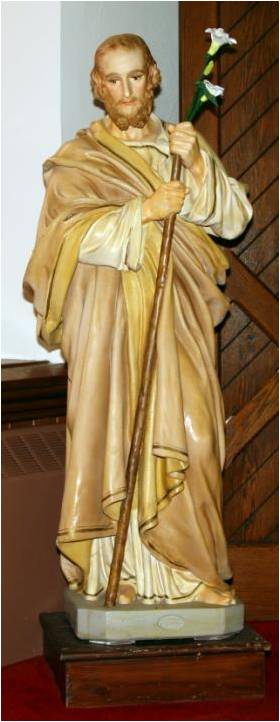
| St. Joseph
There is very little about the life of Joseph in Scripture but still, we know that he was the chaste husband of Mary, the foster father of Jesus, a carpenter and a man who was not wealthy. We also know that he came from the royal lineage of King David. We can see from his actions in scripture that Joseph was a compassionate man, and obedient to the will of God. He also loved Mary and Jesus and wanted to protect and provide for them.
| 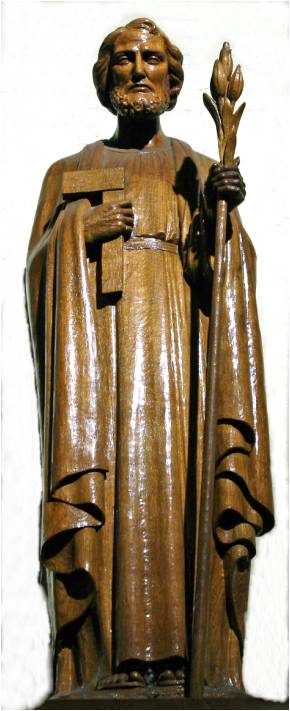
|
|
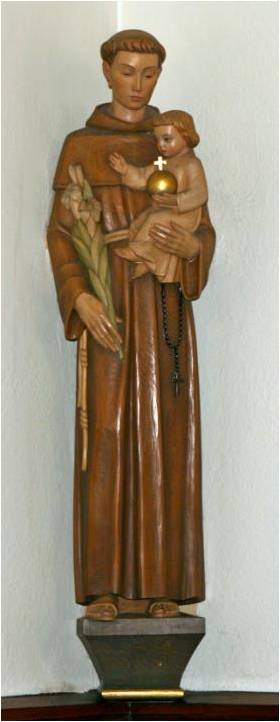
| St. Anthony of Padua
Anthony became a Franciscan and was known for his preaching. He was referred to as the "hammer of the heretics". The child Jesus indicates what Anthony preached about, the Incarnation, the Divine becoming Flesh and dwelling among us. The lily is a sign of purity, innocence and integrity.
|
|
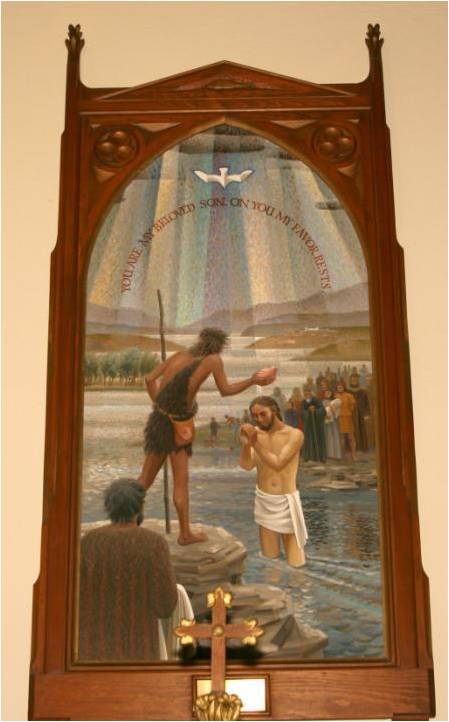
| Baptism of Jesus
An original painting of the baptism of Jesus in the Jordan by John the Baptist. At the top of the painting is a dove. "After Jesus was baptized, he came up from the water and behold, the heavens were opened [for him], and he saw the Spirit of God descending like a dove [and] coming upon him. And a voice came from the heavens, saying, 'This is my beloved Son, with whom I am well pleased.'" MT 3:16-17
|
|
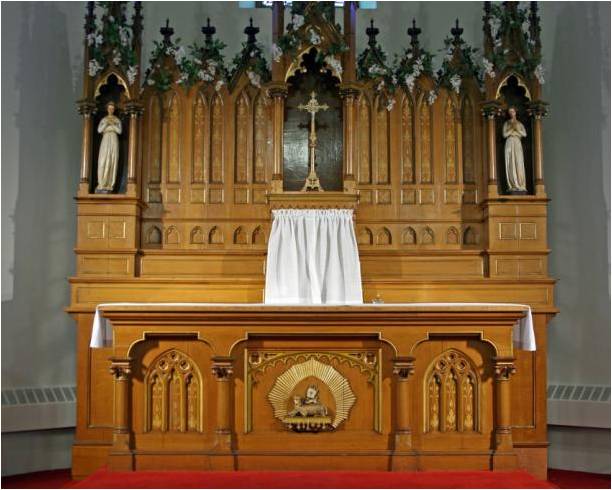
| Altar of Repose
In days gone by this was the altar of sacrifice where the Mass took place. Now it is where the tabernacle the Blessed Sacrament is kept. Above the tabernacle is a cross with angels on either side. The Agnus Dei (Lamb of God ) is at the center of the base of the altar. A lamb seated on a book with seven seals, represents the final judgment when Christ returns in glory. (Rev. 5:11)
|
|
|
Former Presider's Bench at St. Mary's
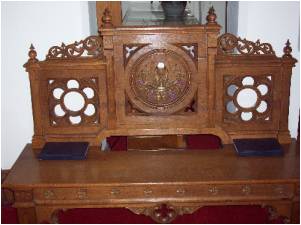
The center symbol where the priest use to sit is of wheat and grapes that are made into bread and wine by human hands, then through the prayer of the priest become the Body and Blood of Christ. |
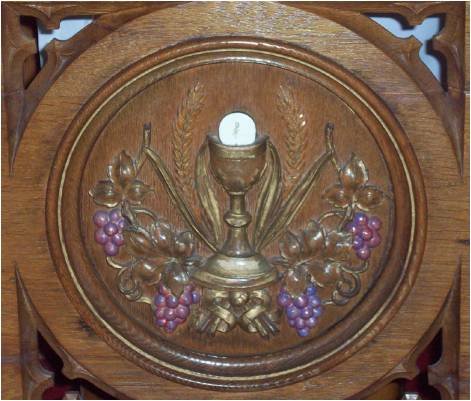
|
|
|
Organ at St. Patrick's
The organ is the traditional instrument that has been used in worship for many years and takes its place among the many different instruments now used. Music in worship provides a beautiful expression of prayer and communal participation that adds to the solemn character of the celebration. |
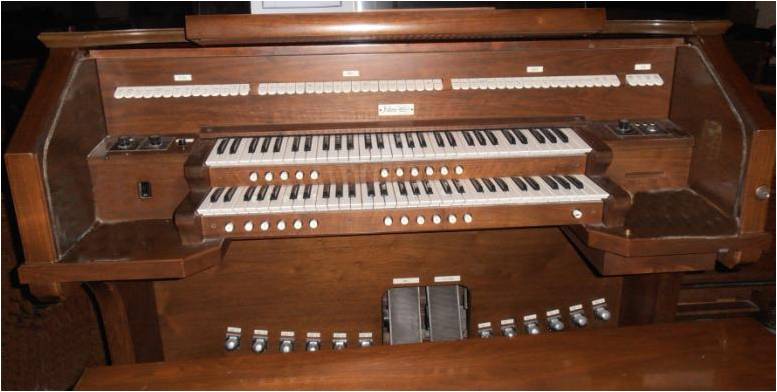
|
|
|
Organ at St. Mary's
The pipe organ at St. Mary's was built by the A.B. Fegelmaker Co. of Erie Pa. in 1900 and consists of over 1200 pipes. The metal pipes in front are not active in producing sound. The wooden pipes behind them produce its beautiful sound. |
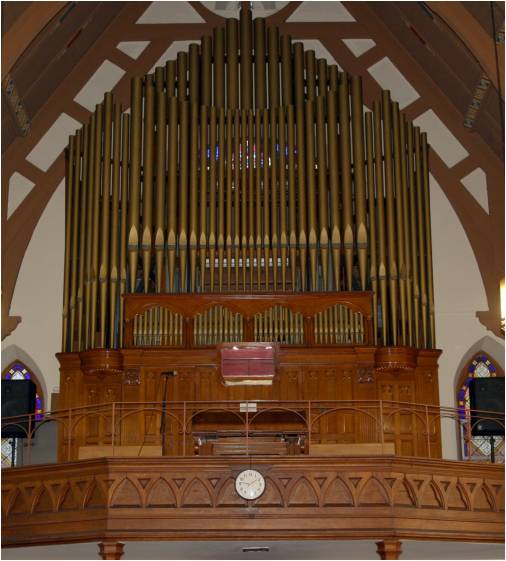
|
|
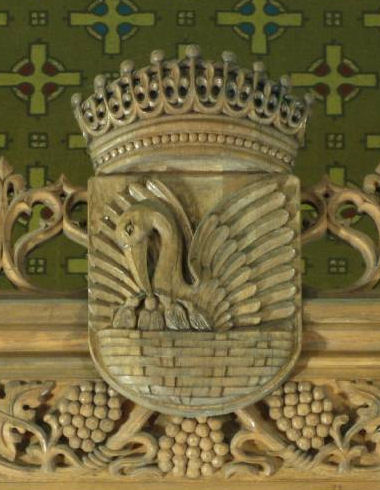
| Pelican
The figure of the pelican-in-her-piety is based on the legend that in times of famine, the mother pelican plucks open her breast and feeds her young on her own blood. During the 13th century, this figure became widely used in Christian art to represent Christ's voluntary sacrifice of atonement.
The crown on top of the pelican is a symbol of royal authority, and is often used for Christ, the King of Kings. Grapes are symbolic of Holy Communion and of the blood shed by Jesus on the cross for the forgiveness of sin. It also shows that Jesus is the fruit of the vine.
|
|
|
Holy Water Fonts
The holy water fonts are used upon entering and leaving the church to help us remember our baptismal promises and commitments. Symbolic or spiritual cleansing. A container of Holy Water is available in each church which can be used for blessings.
|
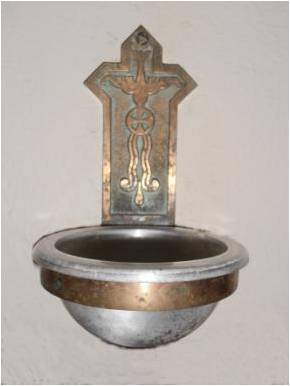
|
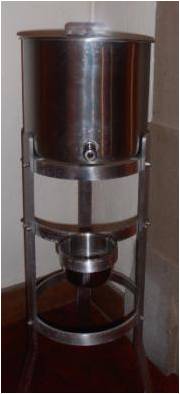
|
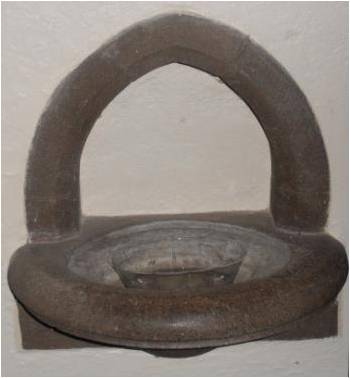
|
|
|

| Easter Candle
The Pascal candle represents the light of our risen Lord and the splendor of his Resurrection. It is lit from the Easter fire at the Easter Vigil Mass. The Alpha and Omega signs are traced as we are reminded of ... Five grains of incense are put on the cross and the center, representing the five wounds of Christ.
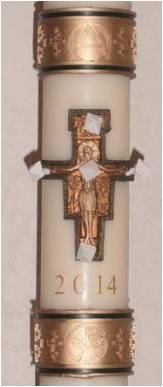
|

|
|
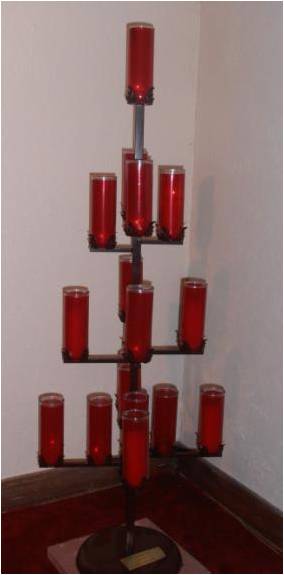
| Votive Candles
Scripture reminds us that Jesus said that he was the Light of the world and told his followers that you are the Light of the world. Catholics light votive candles to shine the love of Jesus on a special request or petition. Even if they are unable to remain waiting in "vigil" in the church, the candle continues to burn as a sign that prayers are being offered. The early Christians would light candles at the graves of the martyrs as a symbol of prayers and intercessions.
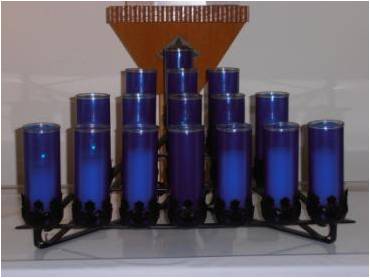
The votive candles at St. Patrick's (left) are located by the tabernacle and by the statue of Blessed Virgin Mary.
At St. Mary's (right) the candles are in front of the Blessed Virgin Mary and the Sacred Heart.
|
|
St. Patrick's
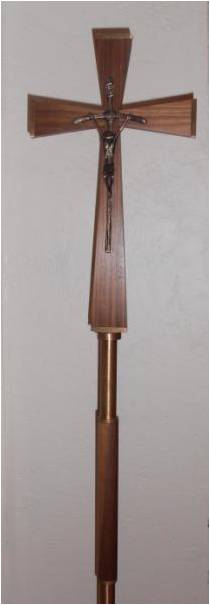
| Processional Cross
A processional cross is simply a crucifix which is carried at the head of a procession, and which, that it may be more easily seen, is usually mounted upon a long staff or handle. This is symbolic of the Christians being followers of Christ. Once the cross is carried to the altar, it may be placed near the altar.
| St. Mary's
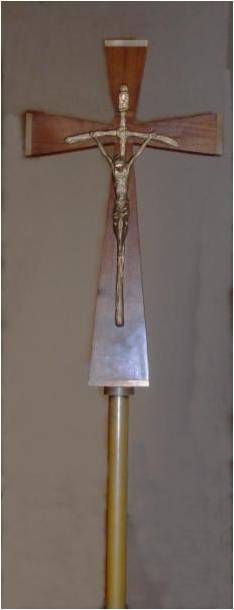
|
|
St. Mary's
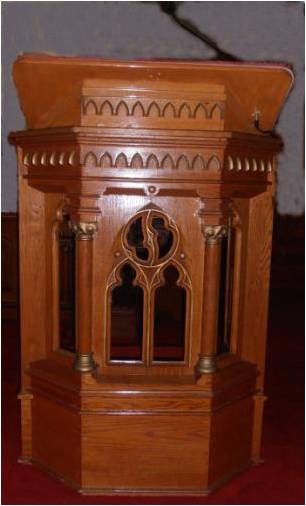
| Ambo
An elevated platform from which Scripture readings are read and the homily preached. The ambo is elevated to show the importance of the Word at Mass.
| St. Patrick's
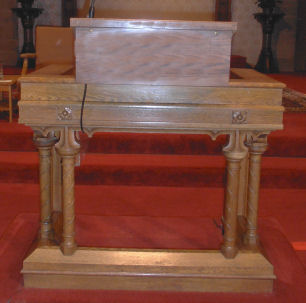
|
|
St. Mary's
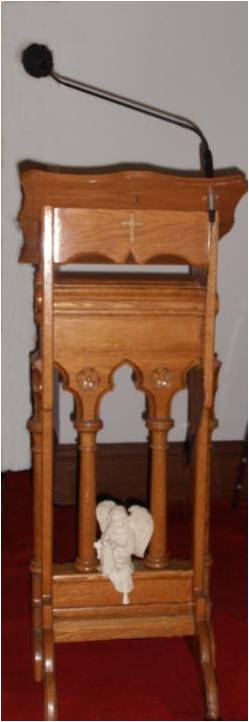
| Lectern
The word lectern comes from the Latin word meaning 'to read,' because the lectern primarily functions as a reading stand. It is used by lay people to read the scripture, except for the gospel, to lead the congregation in prayer, and to make announcements.
| St. Patrick's
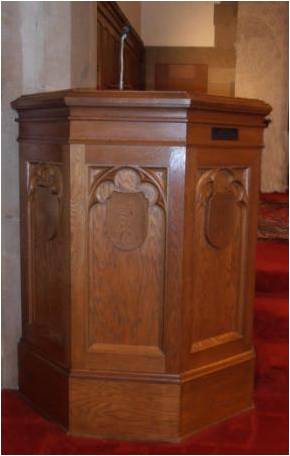
|
|
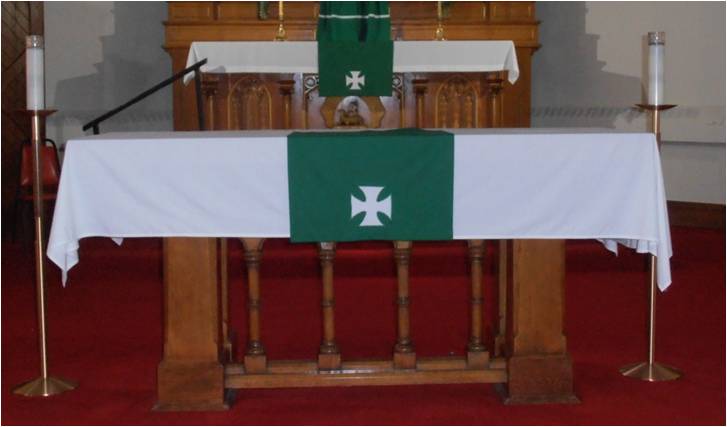
St. Mary's
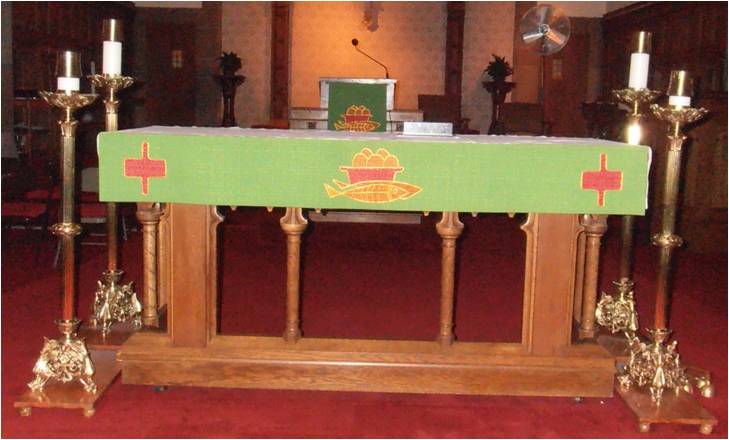
St. Patrick's
| Altar of Sacrifice
"The altar on which the Sacrifice of the Cross is made present under sacramental signs is also the table of the Lord to which the People of God is called together to participate in the Mass, as well as the center of the thanksgiving that is accomplished through the Eucharist." General Instruction of the Roman Missal (GIRM # 296).
|
|
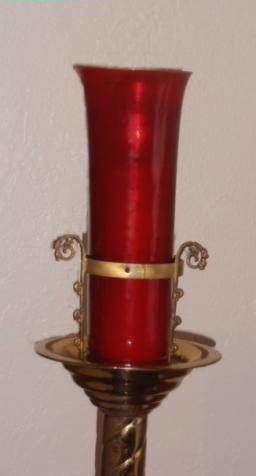
| Sanctuary Lamp
The sanctuary lamp is a red candle light that is located near the tabernacle that is used to show that the Blessed Sacrament is present. The General Instruction of the Roman Missal in the Catholic Church, states (in 316): "In accordance with traditional custom, near the tabernacle a special lamp, fueled by oil or wax, should be kept alight to indicate and honor the presence of Christ."
In the Old Testament, God told Moses that a lamp filled with the pure oil should perpetually burn in the Tabernacle (Ex 27:20-21). This is the precedent for the Catholic Church's custom of burning a candle (at all times) before the tabernacle.
|

|
|
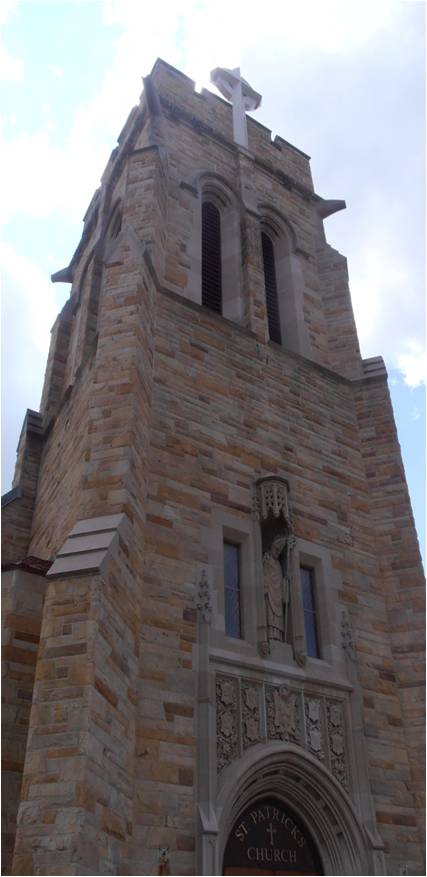
|
Bell Tower
Bell towers contain bells that are used to indicate the time of day, call to worship, or to mark special occasions. St. Mary's tower also contains a clock. St. Mary's tower has three bells that are used for the hour strike and call to worship. An electronic carillon is used for hymns and the Angelus. The bells at St. Patrick's are damaged and can't be used. St. Patrick's uses an electronic carillon.
|
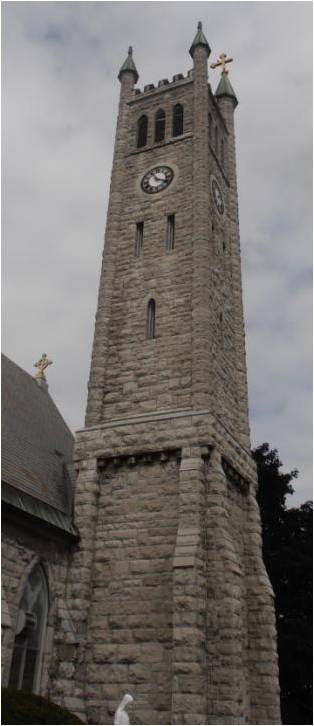
|
|
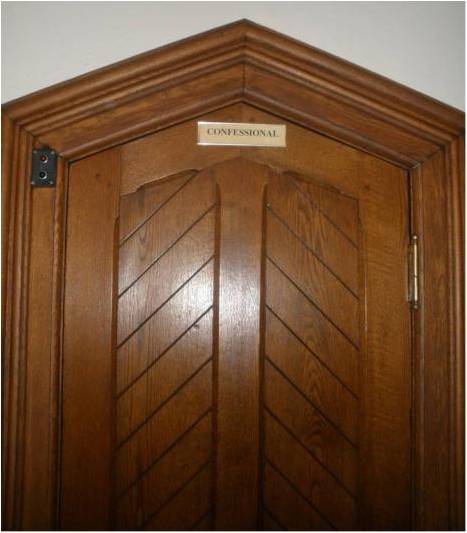
|
Confessional at St. Mary's
The Sacrament of Penance, commonly called Confession, is one of the seven sacraments. Catholics believe that all of the sacraments were instituted by Jesus Christ himself. In the case of Confession, that institution occurred on Easter Sunday, when Christ first appeared to the apostles after his Resurrection. Breathing on them, he said: "Receive the Holy Spirit. For those whose sins you forgive, they are forgiven; for those whose sins you retain, they are retained." (John 20:22-23) Confession take place in the confessional.
|
|
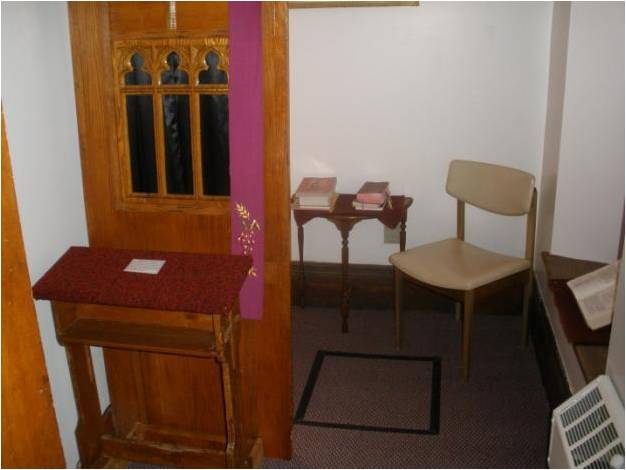
|
Confessional at St. Mary's
When going to Confession, the penitent can speak to the priest face to face or anonymously behind a screen. The priest wears a purple stole which indicates when a priest is engaged in his role as presider during the celebration of a Sacrament. The color purple is associated with penance and with healing.
|
|
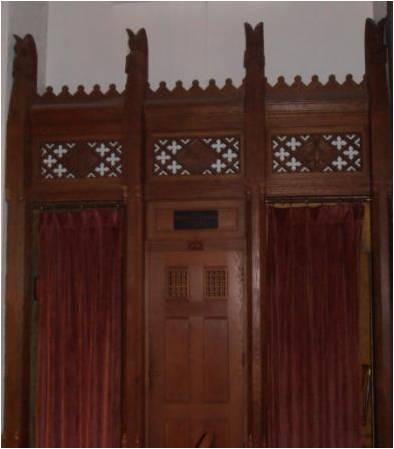
Confessional at St. Patrick's
The confessional at St. Patrick's has four columns with an angel on top of each one. Over the center door is a carving of two keys which refer to the authority of the church to forgive sin in Jesus' name. Two keys represent dual authority to open heaven to repentant sinners and to lock heaven to the unrepentant.
The carving above the penitents is that of a dove, a symbol of the holy Spirit. The words of absolution say in part, "God, the Father of mercies, through the death and resurrection of his Son has reconciled the world to himself and sent the Holy Spirit among us for the forgiveness of sins..."
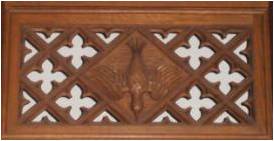
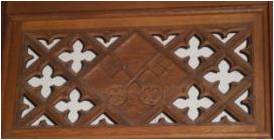
|
|
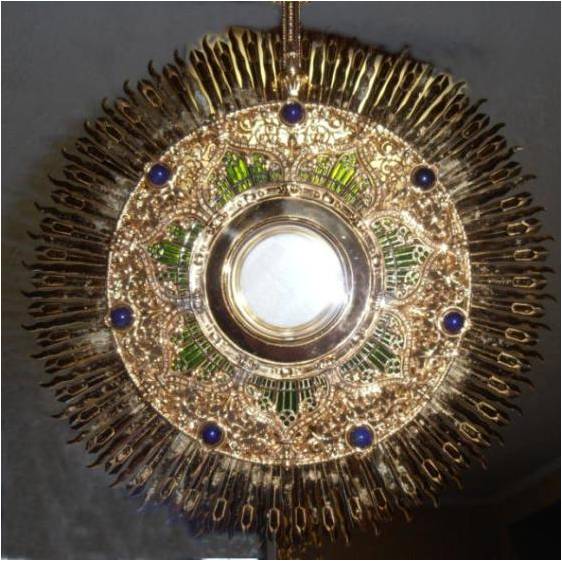
|
Monstrance at St. Patrick's
A monstrance is the vessel used to display the consecrated Eucharistic host, during Eucharistic adoration or Benediction of the Blessed Sacrament. The word monstrance comes from the Latin word monstrare, meaning "to show".
Most monstrances have a cross on the top.
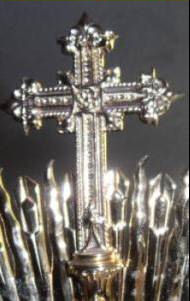
|
|
|
|
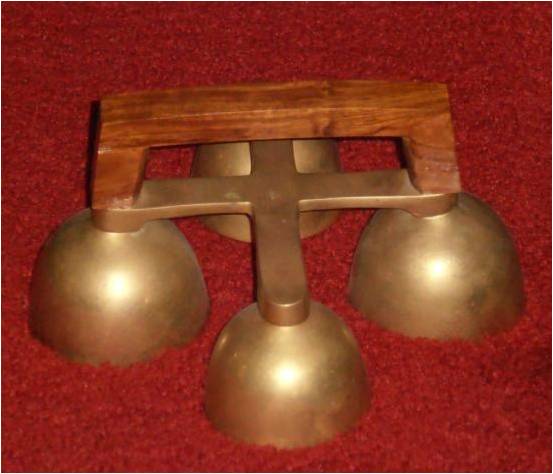
|
Sanctus Bells
The primary reason for the use of sanctus/altar bells is to create a joyful noise to the Lord as a way to give thanks for the miracle taking place atop the Altar of Sacrifice. At the consecration. Another function of the bells is to focus the attention of those attending the Mass that a supernatural event is taking place on the altar.
|
|

|